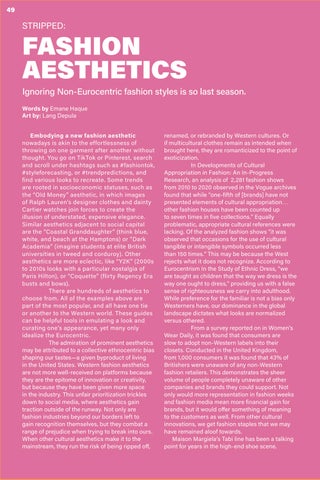49
STRIPPED:
FASHION AESTHETICS Ignoring Non-Eurocentric fashion styles is so last season. Words by Emane Haque Art by: Lang Depula Embodying a new fashion aesthetic nowadays is akin to the effortlessness of throwing on one garment after another without thought. You go on TikTok or Pinterest, search and scroll under hashtags such as #fashiontok, #styleforecasting, or #trendpredictions, and find various looks to recreate. Some trends are rooted in socioeconomic statuses, such as the “Old Money” aesthetic, in which images of Ralph Lauren’s designer clothes and dainty Cartier watches join forces to create the illusion of understated, expensive elegance. Similar aesthetics adjacent to social capital are the “Coastal Granddaughter” (think blue, white, and beach at the Hamptons) or “Dark Academia” (imagine students at elite British universities in tweed and corduroy). Other aesthetics are more eclectic, like “Y2K” (2000s to 2010s looks with a particular nostalgia of Paris Hilton), or “Coquette” (flirty Regency Era busts and bows). There are hundreds of aesthetics to choose from. All of the examples above are part of the most popular, and all have one tie or another to the Western world. These guides can be helpful tools in emulating a look and curating one’s appearance, yet many only idealize the Eurocentric. The admiration of prominent aesthetics may be attributed to a collective ethnocentric bias shaping our tastes—a given byproduct of living in the United States. Western fashion aesthetics are not more well-received on platforms because they are the epitome of innovation or creativity, but because they have been given more space in the industry. This unfair prioritization trickles down to social media, where aesthetics gain traction outside of the runway. Not only are fashion industries beyond our borders left to gain recognition themselves, but they combat a range of prejudice when trying to break into ours. When other cultural aesthetics make it to the mainstream, they run the risk of being ripped off,
renamed, or rebranded by Western cultures. Or if multicultural clothes remain as intended when brought here, they are romanticized to the point of exoticization. In Developments of Cultural Appropriation in Fashion: An In-Progress Research, an analysis of 2,281 fashion shows from 2010 to 2020 observed in the Vogue archives found that while “one-fifth of [brands] have not presented elements of cultural appropriation… other fashion houses have been counted up to seven times in five collections.” Equally problematic, appropriate cultural references were lacking. Of the analyzed fashion shows “it was observed that occasions for the use of cultural tangible or intangible symbols occurred less than 150 times.” This may be because the West rejects what it does not recognize. According to Eurocentrism In the Study of Ethnic Dress, “we are taught as children that the way we dress is the way one ought to dress,” providing us with a false sense of righteousness we carry into adulthood. While preference for the familiar is not a bias only Westerners have, our dominance in the global landscape dictates what looks are normalized versus othered. From a survey reported on in Women’s Wear Daily, it was found that consumers are slow to adopt non-Western labels into their closets. Conducted in the United Kingdom, from 1,000 consumers it was found that 43% of Britishers were unaware of any non-Western fashion retailers. This demonstrates the sheer volume of people completely unaware of other companies and brands they could support. Not only would more representation in fashion weeks and fashion media mean more financial gain for brands, but it would offer something of meaning to the customers as well. From other cultural innovations, we get fashion staples that we may have remained aloof towards. Maison Margiela’s Tabi line has been a talking point for years in the high-end shoe scene.
